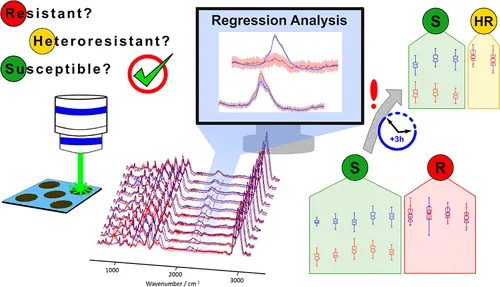"Heteroresistant Bacteria Detected by an Extended Raman-based Antibiotic Susceptibility Test"
Bauer, David; Wieland, Karin; Qiu, Li; Neumann-Cip, Anna-Cathrine; Magistro, Giuseppe; Stief, Christian; Wieser, Andreas & Haisch, Christoph
Analytical Chemistry (2020)
Abstract
Worldwide, multi-resistant bacterial strains are emerging at unprecedented rates. This development seriously threatens the ability of humanity to treat even common infections, resulting in disability and death. Further, this development endangers all medical achievements including cancer therapy or organ transplantations. Therefore, WHO has endorsed antimicrobial resistance as a great threat to humanity. To still allow effective treatment of patients, rapid automated and reliable antibiotic susceptibility testing (AST) of bacterial pathogens is essential. Thereby, speed and sensitivity of the AST results are crucial to improve patient care. Here, Raman spectroscopy as a non-destructive technique providing chemical-specific information is employed to monitor the deuterium uptake of metabolically active bacteria during antibiotic treatment, enabling fast and reliable AST. For this purpose, a bulk sample-preparation method was developed, allowing a high-throughput analysis of a significant number of cells. A protocol was developed for Gram-positive (E. faecalis) and Gram-negative (E. coli) reference strains and tested on 51 clinical isolates with well-characterized resistance phenotypes against ampicillin, ciprofloxacin, meropenem, and vancomycin. Borderline resistant and heteroresistant phenotypes were observed and further investigated. This is of critical importance as the sensitive detection of low frequency heteroresistance in bacterial populations is a huge challenge. Such isolates seem susceptible but are resistant to treatment in vivo. Automatable analysis detects strong phenotypes within 3h. Based on experimental and modelled data, heteroresistance is estimated to be detectable down to frequencies of 10-6 and investigated on clinical isolates as a proof of concept study, however, requiring longer incubation time.
